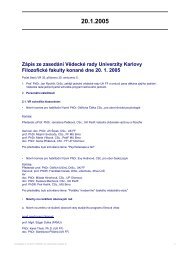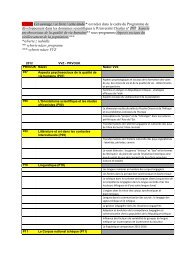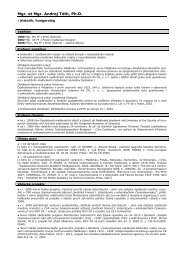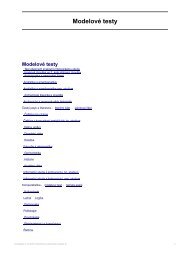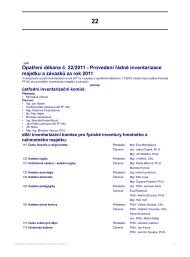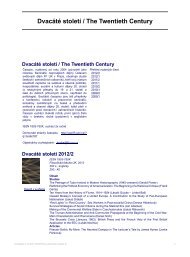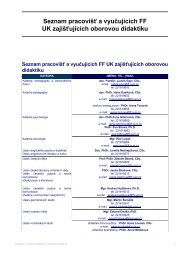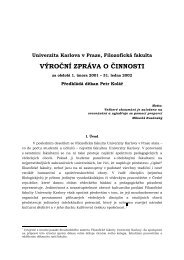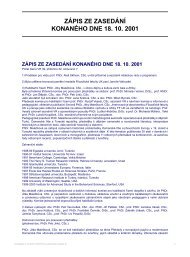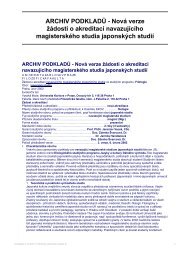Dear Students, This guide is intended particularly for you ...
Dear Students, This guide is intended particularly for you ...
Dear Students, This guide is intended particularly for you ...
Create successful ePaper yourself
Turn your PDF publications into a flip-book with our unique Google optimized e-Paper software.
exacerbated by the problems in Europe of th<strong>is</strong> time (the Great Sch<strong>is</strong>m, critic<strong>is</strong>m of<br />
the Church). The Hussite movement was inspired by the ideas of Master Jan Hus, a<br />
preacher who was burnt at the stake in 1415 at Constance. Despite h<strong>is</strong> death, h<strong>is</strong><br />
supporters successfully continued in their ef<strong>for</strong>ts to re<strong>for</strong>m the Church and even<br />
defeated five consecutive crusades from Rome in the years 1420–1431. The Hussite<br />
movement changed the structure of society in many ways. It created religious dual<strong>is</strong>m<br />
<strong>for</strong> the first time in Chr<strong>is</strong>tian Europe. In the second half of the 16th century the city<br />
experienced great prosperity under emperor Rudolf II and was made the seat of the<br />
Habsburg Empire. Rudolf II establ<strong>is</strong>hed great collections of art and renowned art<strong>is</strong>ts<br />
and scholars were invited to h<strong>is</strong> court. The Habsburg rule however brought the re-introduction<br />
of the Roman Catholic faith, centralization and the construction of a multinational<br />
empire. The Czechs finally lost their national independence to the Hapsburgs<br />
Empire in 1620 at the Battle of White Mountain and <strong>for</strong> the next 300 years remained<br />
part of the Austrian Monarchy. After the defeat of the Austro-Hungarian Empire<br />
in World War I, Czechs and Slovaks declared independence in 1918 and Czechoslovakia<br />
was establ<strong>is</strong>hed as a sovereign state. <strong>Th<strong>is</strong></strong> united the Czech territory with<br />
a part of Hungary inhabited by Slovaks and Ruthenians, who speak a language similar<br />
to Czech. During the 1920s and 1930s, Czechoslovakia ranked among the ten most<br />
developed countries in the world. After Hitler’s occupation of the country in 1938 (as<br />
a result of the infamous Munich Agreement), Czechoslovakia was split into two parts:<br />
the Protectorate of Bohemia and Moravia, and the Slovak state. The Czechoslovak<br />
statehood was restored after World War II ended in 1945, but the country suffered<br />
a territorial loss. The most eastern part, Transcarpathian Ukraine, was annexed to<br />
the Soviet Union.<br />
The events leading up to World War II as well as the war itself strengthened the<br />
left<strong>is</strong>t orientation of a significant part of the population. Nationalization of mines,<br />
key industries, banks and insurance companies in October 1945 affected more than<br />
60% of the economy. The Commun<strong>is</strong>t party won the 1946 parliamentary elections in<br />
Bohemia, which led to a cabinet cr<strong>is</strong><strong>is</strong> in 1948, and the Commun<strong>is</strong>t party <strong>for</strong>med the<br />
next cabinet. <strong>Th<strong>is</strong></strong> resulted in regime change and brought the country into the international<br />
commun<strong>is</strong>t movement, led by the Soviet Union. Subsequently, th<strong>is</strong> brought<br />
about Soviet influence in all practical matters concerning the country and the lives of<br />
its citizens. The entire economy became naturalized, and was, to a great extent, run<br />
to meet the needs of the Soviet bloc. In addition, the state admin<strong>is</strong>tration became<br />
entirely centralized. The ef<strong>for</strong>ts and enthusiasm towards liberalization of the regime<br />
in the 1960s (known as the 1968 Prague Spring) were too short-lived to succeed.<br />
A turning point in the h<strong>is</strong>tory of Czechoslovakia came in November 1989, when<br />
the social<strong>is</strong>t regime renounced its power during the so-called “Velvet Revolution.”<br />
<strong>Th<strong>is</strong></strong> movement, initiated by students and intellectuals, was soon supported by the<br />
common people, who <strong>for</strong>med a group called the Civic Forum, committed to bringing<br />
in democracy and a market economy. Free parliamentary elections in June 1990 confirmed<br />
the course of democratic development. At th<strong>is</strong> time, Czechoslovakia, a unitary<br />
state, became a federation known as the Czech and Slovak Federal Republic.<br />
The federal structure did not last <strong>for</strong> long, however, as politicians of the two republics<br />
held different views on the content and degree of economic and social re<strong>for</strong>ms.<br />
After the 1992 elections, the split of the Czechoslovak state and emergence of two independent<br />
states (the Czech Republic and the Slovak Republic) could not be avoided.<br />
The constitution of the Czech Republic was passed on December 12, 1992. Since the<br />
emergence of the new country, the <strong>for</strong>eign policy ef<strong>for</strong>ts of successive governments<br />
have been focused on joining the Euro-Atlantic structure and the “europeanization” of<br />
the country. In keeping with these policies, the Czech Republic became a member of<br />
the OECD in 1995, signed the Europe Agreement in 1995, joined NATO in 1998, ratified<br />
accession to the EU in 2003 through a referendum, and became a Member State<br />
of the EU in May 2004. In 2008 Czech Republic became a part of Schengen area.<br />
6 7




